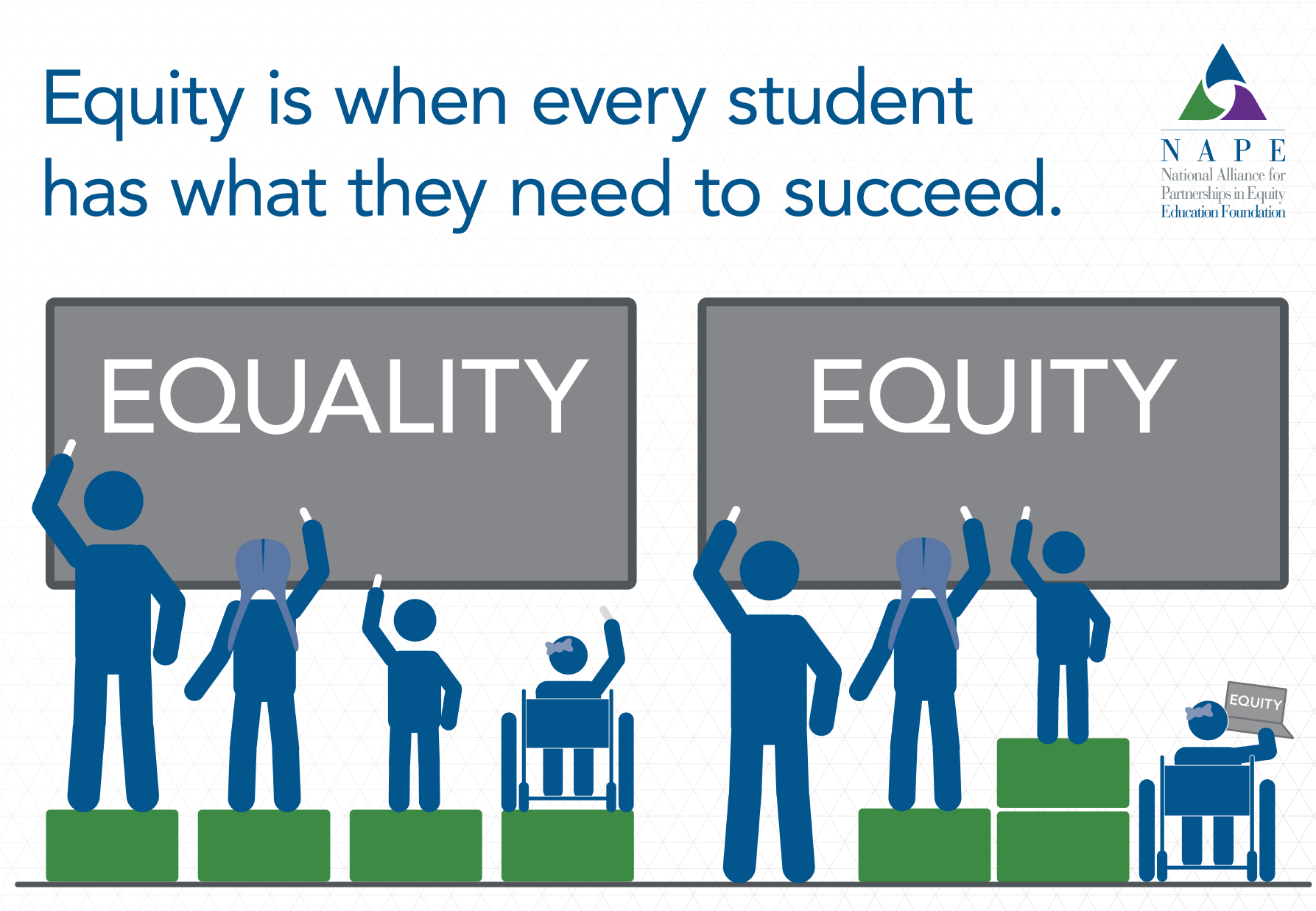jump to resource list
Unpacking equity in education in under 60 minutes is a tall order. But it’s one Dr. Nikole Hollins-Sims took head-on during Remake Learning’s virtual Lunch & Learn on August 17.
Nikole, an educational consultant with the Pennsylvania Training and Technical Assistance Network (PaTTAN) and a special equity consultant with the Pennsylvania Department of Education (PDE), designed her session to help educators “fill-up” on equity resources before they jumped into a back-to-school season that’s unfolding amidst a global pandemic and ongoing racial unrest.
Nikole took attendees on a tour of the PDE’s framework for equitable practices, but made plenty of pit-stops along the way, to share tips, tools, books, courses, and other resources. Perhaps most importantly, she took the time to explain several prerequisites, definitions, and subtle distinctions that are essential to every educator’s journey in equitable teaching and learning.
Watch the full recording of Nikole’s Lunch & Learn on YouTube.
Understanding Identity
The session opened with a slide featuring a few of Nikole’s personal photos and a list of adjectives.
“This is pretty much who I am…what makes Nikole, Nikole,” she explained. “School psychologist by training, a wife, a mother, a sister, an only daughter, a family member, church member, Virgo, alumna.”
Using her own experiences as an example, Nikole explained that aspects of identity are what comprise learners’ unique backgrounds–an identity “backpack” of sorts, that they pull on every day along with their Jansport.
When students enter a school or classroom, they show up with their backpack, and its contents represent their needs as learners. Educators may not always be aware of these needs, but they are nonetheless vital to creating a sense of safety for young people in the classroom.
And that is the core of equity in education: providing structures and conditions where young people have an opportunity to feel physically, psychologically, and emotionally safe.
Nikole then invited attendees to describe their own identities: Parent. Daughter. Sister. Friend. Lifelong learner. Nurteror. Advocate. Lover of colored pencils.
Like learners, educators bring their identities into classrooms too, where their traits can influence interactions with students and their understanding of equity.
“When we do equity work, pieces of ourselves show up in that work, so it’s important to understand those components of our lives,” she explained. “[we need to] acknowledge that we have things that make us who we are and impact how we show up in our educational sphere.”
Overcoming Misunderstandings in Equity
Districts and schools must also commit to a level of understanding before embarking on meaningful training or assistance. Specifically, they must understand the definitions and factors at play behind the concept of equity.
“What we’re finding…is that there’s a misunderstanding around what it is that folks want out of equity supports,” she said. “Schools want to jump immediately to the action,” like pedagogy and practices. “But you have to begin with the history…and truly understand what equity is.”
Districts often tell her they want equity training, but what they’re really asking for is an exercise in self-awareness and a focus on anti-racist practices.
Nikole stressed the distinction between these two efforts: Equity is a large umbrella, while anti-racism work is a very important component that falls under that greater umbrella.
Conversely, she sometimes hears educators say: “Equity does not apply to me…we are in a rural district and don’t have racial diversity.”
But, rural districts still have students who don’t represent the dominant culture, students who are homeless, have disabilities, or identify with a different gender or sexual orientation. Plus, rural communities “need to know as much about race as suburban and urban communities because we interact on a constant basis, and if we truly want to employ anti-racist approaches, we have to reach everyone.”
Taken together, these points open the door to a much deeper definition of equity in learning.
“Oftentimes, people think it’s just one type of district or one group of people that always receive the short end of the stick…but when you really unpack the different levels of inequities that happen in education, they’re vast.”
Pennsylvania’s definition of equity not only includes race and ethnicity, but gender, language, disability, sexual orientation, family background and/or income, and it affords all learners access to the educational resources and rigor they need at the right moment.
Educational inequities can also be tied to cultural, familial, and programmatic realities. They can even live in elements of a district’s staffing–like urban schools who struggle to recruit teachers of color or rural communities who struggle with recruitment in general–or instruction–like lack of access to AP courses, gifted placement, or special education identification.

Equitable practices help address these gaps and differences, by giving each student what they need to access learning content. This shouldn’t be confused with equality, however, which gives every student the same level of assistance but has no regard for individual needs, leaving some students still unable to access learning content.
Without an understanding of equity and intentional use of equitable practices, disproportionate student outcomes–those based on biases and subjective behaviors–can run rampant. Disproportionality, in turn, poses “a big barrier that keeps success from happening for certain students,” Nikole explained.
That’s why it’s so vital for schools and districts to systematically implement equitable learning practices.
Frameworks to Support Equity Practices
Educators can feel overwhelmed by the idea of authentic equity work, especially those who are just getting started. But equity frameworks can help: They offer guidance to any and every educator who’s working to implement equitable learning practices.
First, Nikole stressed, it’s important to understand that equity implementation is a type of MTSS, or multi-tiered system of support. By framing equity implementation as an MTSS, it becomes a holistic effort that focuses on academics, behavior, and social-emotional outcomes–not a stand-alone program or curriculum specific to a subgroup.
The PDE has also developed a more detailed framework to address the many types of educational inequities.
They outline five “pillars of practice” for equity implementation: self-awareness, data practices, family and community engagement, academic equity, and disciplinary equity.
Not surprisingly, the framework begins with educators building a core understanding of identity.
“I opened the session that way that I did because that was an exercise…of self-awareness,” Nikole said, “where you start to understand ‘maybe I reacted to those students that way because of what I saw on TV my whole life.’”
Self-awareness can also extend to examinations of power dynamics and privileges connected to race, sexual orientation, and other demographics.
“That’s a level of self-awareness, to be able to recognize privilege and address it or use it in an appropriate way to dismantle barriers,” Nikole explained.
Once educators have established a level of self-awareness, they’re ready to analyze larger, system-wide data, like disproportionality data, and see what it reveals about their school.
For instance, according to data Nikole cited, males, students of color, and students with disabilities are disproportionately referred for certain disability categories or behavioral interventions, like being sent to the office, suspended, or expelled.
Armed with data, schools can begin to build an action plan for policy and practice. But, it’s crucial that they involve families and communities in the planning process.
“There’s no way we can be responsive to our students without knowing where they also come from…and the values that are part of their own communities,” she said.
These efforts open the door to the final two pillars, which directly address academic and disciplinary inequalities–and the disproportionate outcomes they fuel.
Later this month, PDE will release the Equitable Practices Virtual Hub, a site to guide educators through each of its five pillars of practice. The hub will also include a prerequisite equity audit so that users have a clear understanding of how they should navigate the hub and what resources they should focus on.
Looking ahead, the hope for the hub, the pillars of practice, and all the connected work Nikole covered is to move the needle of equity in education forward, in both the short-term and long-term.
“Equity, for the purposes of right now, is the goal…but the eventual, long-term goal is the systemic dismantling of the barriers that inhibit equity from happening,” she said. “We need to focus not only on equality versus equity, but also liberation.”
Resources
A quick list of tools, terms, sites, and other resources referenced during Nikole’s session:
- PA Equitable Practices Virtual Hub – Guidance and resources on PDE’s five pillars of equity tailored to district/school-, classroom-, or individual-level needs.
- Pennsylvania Equity and Inclusion Toolkit – Outlines a sequence of supports in three core areas — prevention, response, and recovery — to help districts and schools navigate the needs of students, parents, media, and other stakeholders following events of racial injustice or other inequities.
- Universal Design for Learning – a framework to improve and optimize teaching and learning for all people based on scientific insights into how humans learn
- Mid-Atlantic Equity Consortium (MAEC) Equity Audit – Includes three of MAEC’s equity tools: Criteria for an Equitable School, Criteria for an Equitable Classroom, and Teacher Behaviors that Encourage Student Persistence.
- Equity Teacher Effectiveness Courses – Two free courses offered via PDE’s standards-aligned system, designed to build school leader and teacher capacity in equity. Act 48 credits provided.
- Cultural Proficiency: A Manual for School Leaders – A book that leads readers on a journey toward cultural proficiency that results in professional growth and organizational change!
- Relative Risk Ratio Map – Part of a study conducted by Princeton University researchers that examines the disproportionate percentage of black students who received out-of-school suspensions compared to white students.
- Speak Up Against Bias – Tolerance.org’s pocket guide for responding to everyday bias, prejudice, and stereotyping.
